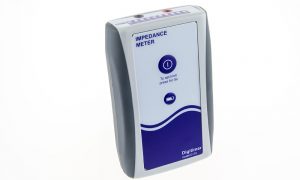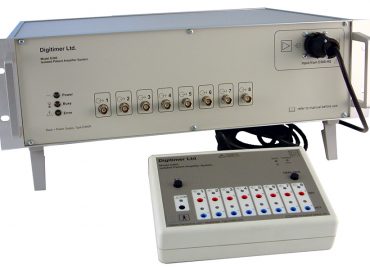The Importance of Skin-Electrode Impedance
in Electrophysiological Recording & Stimulation
Why is electrode impedance significant in biopotential recording applications?
In order to make high quality physiological or diagnostic measurements using techniques like electrocardiography (ECG), electromyography (EMG) or electroencephalography (EEG), it is important that the skin-electrode interface provides stable and balanced electrode impedances. While modern differential isolated EMG amplifiers such as the Digitimer D360, new D360R and D440 use custom-designed circuitry with low noise characteristics and excellent common-mode rejection capabilities, effective skin preparation and appropriate electrode selection can make a tremendous difference to the quality of the amplified signals, enhancing the confidence the researcher or clinician has in the quality of their data.
When making any recordings of this type, the goal is to maximize the amplitude of the signal of interest while minimising noise i.e. achieving the best possible signal to noise ratio. Reduced noise not only makes data easier to visualise, but measurements are more accurate and significant differences between data sets becomes more obvious. As a result, a short amount of time invested in the preparation of the electrode site can reap tremendous rewards in terms of data quality.
The importance of skin-electrode impedance in electrical stimulation
It’s not just in neurodiagnostic recording applications that impedance has a role to play, as skin-electrode impedance can also influence the success or failure of electrical stimulation. All electrical stimulators are hardware limited in terms of the voltage and current they can supply to a subject or preparation and in the case of a constant current stimulator, the ability of a stimulator to deliver the requested current is determined by the “voltage compliance” of the stimulator.
![]()
Voltage compliance is essentially the maximum voltage that a constant current stimulator can produce in order to pass the requested current, and as impedance increases, the voltage needed to pass this current also increases. If the impedance becomes too high, the compliance limit of the stimulator will be exceeded and the stimulator will fail to pass the current required to activate a particular muscle or nerve. Due to the higher voltages need to pass the stimulus, high impedances can also increase the size of stimulus artefacts, making it impossible to resolve a short latency evoked response from the artefact.
Why do we refer to impedance and not resistance?
The terms “resistance” and “impedance” are often used interchangeably in the areas of physiological measurement or electrical stimulation. however, they are two distinct physical properties.
 Resistance only applies to DC currents and is a measure of a circuit’s ability to resist a constant current flow. In contrast, impedance reflects the characteristics of a circuit that is carrying an AC current. The difference between resistance and impedance arises because an AC current flowing through a circuit will face opposition due to resistance as well as reactance (inductance or capacitance). In over-simplified terms, the skin-electrode interface can be modelled as a resistor and capacitor in parallel, rather than just a resistor.
Resistance only applies to DC currents and is a measure of a circuit’s ability to resist a constant current flow. In contrast, impedance reflects the characteristics of a circuit that is carrying an AC current. The difference between resistance and impedance arises because an AC current flowing through a circuit will face opposition due to resistance as well as reactance (inductance or capacitance). In over-simplified terms, the skin-electrode interface can be modelled as a resistor and capacitor in parallel, rather than just a resistor.
The effect of variable impedance on EMG recordings
Electrode impedances can vary from several kohms for large surface area hydrogel electrodes to hundreds of kohms for EMG needles and while the actual impedance is not critical to performance, stable and consistent (balanced) impedances across all electrodes is vital. In the case of surface electrodes, experienced EMG or electrical stimulation users will take time to carefully prepare each electrode site with abrasive gels and/or alcohol wipes to remove the outer layers of skin and surface oils. This has the double effect of lowering and balancing impedances at each site.
 Wide variations in electrode impedance lead to an impedance imbalance which amplifier circuits can struggle to cope with, resulting in lower signal to noise ratios. Likewise, impedances that change over time, will have a similar effect on the quality of an EMG or EEG recording. Effective skin preparation also reduces the magnitude of the DC potential present at the skin-electrode interface.
Wide variations in electrode impedance lead to an impedance imbalance which amplifier circuits can struggle to cope with, resulting in lower signal to noise ratios. Likewise, impedances that change over time, will have a similar effect on the quality of an EMG or EEG recording. Effective skin preparation also reduces the magnitude of the DC potential present at the skin-electrode interface.
How can I measure skin-electrode impedance?
Our D175 Impedance Meter is an example of an easy to use, hand-held instrument that may be used to measure the impedances of stimulating or recording electrodes in the range of 0-50kohms. This compact, battery-powered device has an array of bi-colour LEDs that makes it easy for the operator to quickly assess the potential quality of an electrode site.
 The D175 measures the total impedance through a pair of electrodes placed on the skin, by passing a very small biphasic (charge-neutral) current between them. Once electrodes have been positioned on the recording/stimulation sites, a pair of electrode lead wires should be connected to the RED and BLACK electrode sockets (1.5mm DIN 42802) on the top of the D175. The sockets are colour coded for no reason other than to help the user identify which electrode is being used as the reference. With the electrodes connected and with the D175 switched ON (and in METER MODE), the D175 should display the measured impedance.
The D175 measures the total impedance through a pair of electrodes placed on the skin, by passing a very small biphasic (charge-neutral) current between them. Once electrodes have been positioned on the recording/stimulation sites, a pair of electrode lead wires should be connected to the RED and BLACK electrode sockets (1.5mm DIN 42802) on the top of the D175. The sockets are colour coded for no reason other than to help the user identify which electrode is being used as the reference. With the electrodes connected and with the D175 switched ON (and in METER MODE), the D175 should display the measured impedance.
Having identified one or more electrodes that have a “good” impedance level, these can then be used as reference electrodes for the remainder. If bad/high impedances are found, it may be necessary to replace one or both of the electrodes following additional skin preparation, according to the standard recommended practice.
For display purposes, measured impedances are rounded up to the next highest displayable value, i.e 4 kohm lights up the 5 kohm LED. By pressing and holding the Power Button for longer than 4 seconds, the D175 will enter the SETUP MODE and allow the operator to change the level at which the LEDs illuminate green or red. In SETUP MODE, the LED corresponding to the highest “good” (green) level will flash green. The D175 preserves battery power by switching off if a button is not pressed for a period of greater than one minute.
Further Reading
Covering far more than just the impact of skin-electrode impedance, we recommend that anyone wanting to learn more about instrumentation, methodological and technical aspects of EMG recording take a look at the paper by Hatice Tankisi et al., which presents an updated consensus report on “Standards of Instrumentation of EMG”.
Hatice Tankisi, David Burke, Liying Cui, Mamede de Carvalho, Satoshi Kuwabara, Sanjeev D. Nandedkar, Seward Rutkove, Erik Stålberg, Michel J.A.M. van Putten, Anders Fuglsang-Frederiksen,
Standards of instrumentation of EMG, Clinical Neurophysiology, Volume 131, Issue 1, 2020, Pages 243-258, ISSN 1388-2457,
https://doi.org/10.1016/j.clinph.2019.07.025




